Formatting
Layout and formatting
Layout and formatting options for the score can be accessed mainly from the Layout and Style menus.
Ways to affect layout
This section lists the main commands and dialogs affecting score layout. Other formatting options are covered in either Layout menu or Style menu below (for text, see Text styles and properties).
From the Layout menu:
-
Page Settings: Adjust the overall dimensions of your score such as page size, page margins, and scaling.
-
Increase Stretch/Decrease Stretch: Adjust the score spacing by stretching or squashing selected measures.
From the Style menu:
-
Score Style: Set overall score details, such as music font, display of multi-measure rests, and whether to hide empty staves.
-
Page Style: Adjust staff and system spacing, score and lyric margins etc.
-
Measure Style: Set the measure spacing, which affects the number of measures per line.
-
Sizes: Set the default size of "small" and grace notes, small staves and small clefs.
Other commands:
-
Add/Remove line breaks: Set the number of measures per system.
-
Breaks and spacers: Apply line, page or section breaks. You can also add extra space between particular systems or staves where needed.
Layout menu
Page Settings...
See Page settings.
Reset
The Reset command restores all selected score elements to their default position. It also restores the default directions of note stems and beams. To apply:
- Select the elements or the region of the score that you wish to reset. Or use Ctrl+A to select the whole score.
- Press Ctrl+R; or from the menu select Layout→Reset.
Increase Stretch/Decrease Stretch
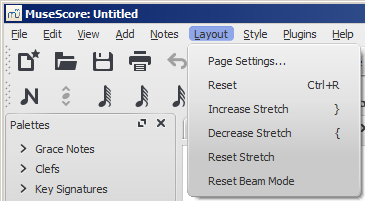
Increase or decrease the horizontal spacing of notes within selected measures. To apply:
- Select a range of measures. Or use Ctrl+A to select the whole score.
- Chose one of two options:
- To increase stretch:
- Use the shortcut } (right curly bracket) (Mac: Ctrl+Alt+9);
- Or from the menu bar, select Layout→Increase Stretch;
- To decrease stretch:
- Use the shortcut { (left curly bracket) (Mac: Ctrl+Alt+8);
- Or from the menu bar, select Layout→Decrease Stretch.
- To increase stretch:
See also Measure Properties: Layout stretch. This allows you to set the stretch more precisely.
Reset Stretch
To reset stretch to the default spacing of 1:
- Select a range of measures. Or use Ctrl+A to select the whole score.
- From the menu, select Layout→Reset Stretch.
Reset Beam Mode
To restore beams to the mode defined in the local time signatures:
- Select the section of the score you want to reset. If nothing is selected, the operation will apply to the whole score;
- Select Layout→Reset Beam Mode.
See also Beams.
Regroup Rhythms
As of version 2.1, this option corrects note ties, durations and beaming so that they are grouped according to standard music notation practice. For example:
Before:

After:

Any notes that are tied and are the same length as a dotted note will be changed to the dotted note with two limitations. (i) Only the last note of a group of tied notes will have a single dot. Notes with more than one dot are not produced using this option. (ii) Dotted notes will not span from one group of beamed notes to another unless their duration is the same as all of the beam groups it covers. Any notes with more than one dot will be regrouped according to the above rules.
To apply:
- Select the section of the score you want to reset. If nothing is selected, the operation will apply to the whole score;
- Select Layout→Regroup Rhythms.
Note: This is an experimental feature and there are known bugs. Articulations and ornaments are deleted and some pitches respelt. Ties across barlines may be lost on UNDO.
Style menu
General: Score
To open the Score dialog: from the menu, select Style→General...→Score.
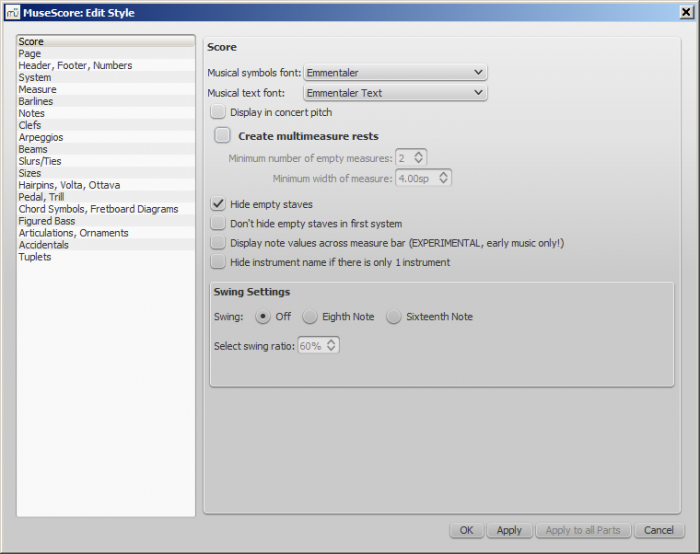
This dialog allows you to set global properties, such as the music font, display of multimeasure rests, whether or not to hide empty staves, "swing" playback etc.
- Musical symbols font: Choice of display in Emmentaler, Bravura or Gonville fonts.
-
Musical text font: Choice of display in Emmentaler, Bravura, Gonville or MuseJazz fonts.
-
Display in concert pitch: Tick this option to display the score at concert pitch. If unticked the score is displayed at written pitch.
-
Create multimeasure rests: Tick to display multimeasure rests.
- Minimum number of empty measures; The default is 2.
- Minimum width of measure: The default width is 4 sp.
-
Hide empty staves: This option saves space by hiding those staves in a system which consist of only empty measures. Used for condensed scores.
-
Don't hide empty staves in first system: Always display staves in first system even if they consist of empty measures.
-
Display note values across measure bar: A feature useful for notating early music. See Unbarred notation.
-
Hide instrument name if there is only one instrument: You don't usually need to display the instrument name in this case.
-
Swing setting: The default is off. Choice of swung eighth or sixteenth notes.
- Select swing ratio: The default setting is 60%.
See also, Swing
General: Page
To open the Page dialog: from the menu, select Style→General...→Page.

This dialog allows you to adjust the space above and below systems, staves, lyrics, and vertical frames; and between the score and the top/bottom page margins. You can also control the display of key signatures, time signatures and clefs.
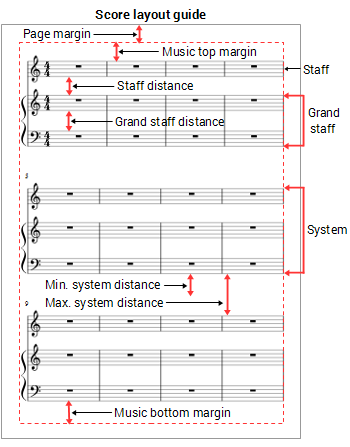
Distance to page margins
- Music top margin: The distance between the top staff line of the first staff on the page and the top page margin.
- Music bottom margin: The distance between the bottom staff line of the last staff on the page and the bottom page margin.
Distance between staves
- Staff distance: The space between staves which are not part of a grand staff (see below).
- Grand staff distance: The space between staves that share the same instrument—such as the piano, organ, or those of a guitar staff/tab pair.
Note: To alter the space above one particular staff see Extra distance above staff (Staff properties).
Distance between systems
- Min. system distance: The minimum distance allowed between one system and the next.
- Max. system distance: The maximum distance allowed between one system and the next.
Lyrics Margins
- Lyrics top margin: The height of the margin above the top lyrics line (in a system).
- Lyrics bottom margin: The height of the margin underneath the bottom lyrics line (in a system).
- Lyrics line height: The distance between lyrics line (in a system), expressed as a percentage of the line height associated with the lyrics text style.
Vertical frame margins
- Vertical frame top margin: The default margin height above a vertical frame.
- Vertical frame bottom margin: The default margin height below a vertical frame.
Last system fill threshold
- If the last system is longer than this percentage of the page width, it gets stretched to fill that width.
Clefs and key signatures
- Create clef for all systems: Untick this box to prevent a clef from automatically displaying at the start of any system except the first.
- Create key signature for all systems: Untick this box to prevent a key signature from automatically displaying at the start of any system except the first.
Ticking the following boxes, allows the display of courtesy elements at the end of systems:
- Create courtesy time signatures:
- Create courtesy key signatures
- Create courtesy clefs
General: Header, Footer, Numbers
Open from the menu: Style→General...→Header, Footer, Numbers.
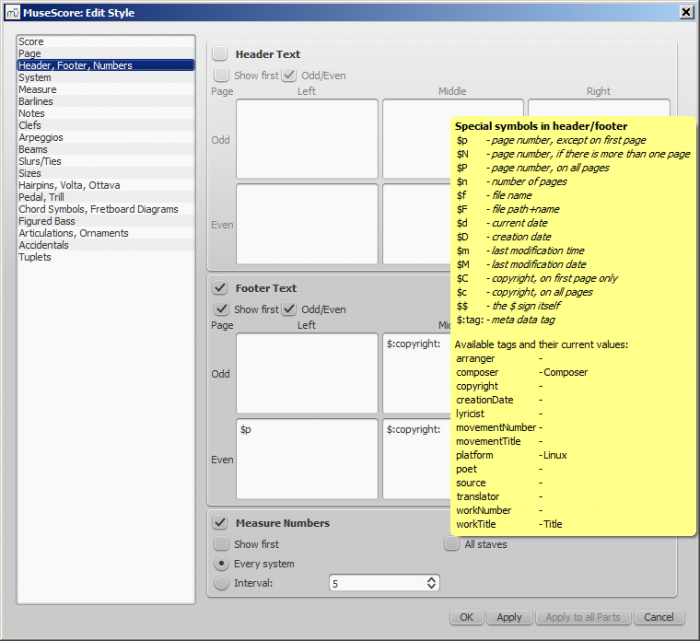
You can show the content of a score's meta tags (see Score information) or show page numbers in a header or footer for your score. To create a header or footer for a score with linked parts, make sure the main score is in the active tab. To create a header or footer for an individual part, that part needs to be the active tab.
If you hover with your mouse over the Header or Footer text region, a list of macros will appear, showing their meaning, as well as the existing meta tags and their content.
You can create different Headers and Footers for even and odd pages, such as putting page numbers on the right for odd-numbered pages and on the left for even-numbered pages.
You can also edit whether and how often measure numbers appear.
General: System
Open from the menu: Style→General...→ System.
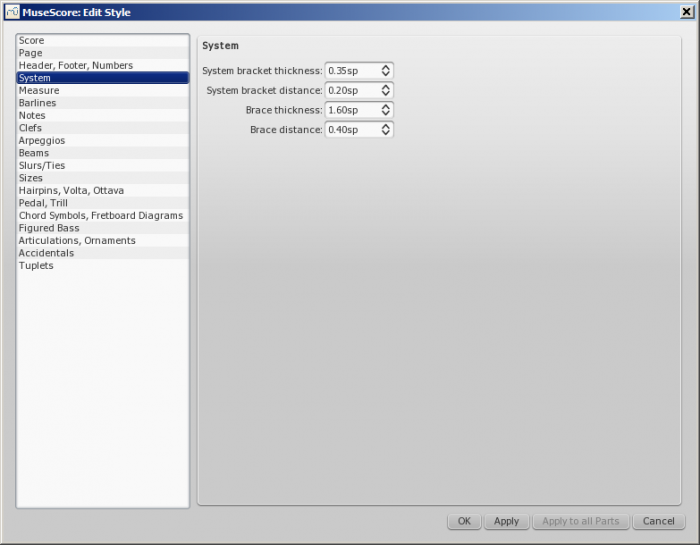
This dialog allows you to:
- Set the distance between system brackets or braces and the start barlines.
- Set the width of system brackets and braces.
See also Brackets.
General: Measure
General: Barlines
Open from the menu: Style→General...→Barlines.
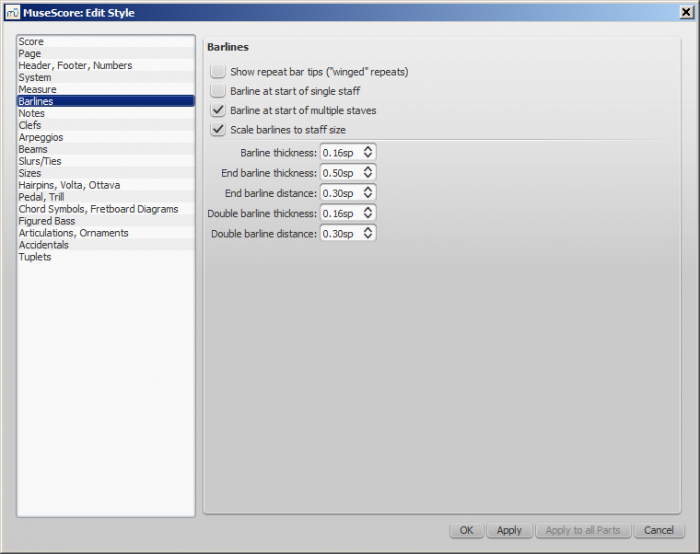
- Control whether to show barlines at the beginning of a staff or multiple staves.
- Scale barlines to staff size affects "small" staves only. See Barline adjustment possibilities (external link) for details.
- Control proportion of thickness and distance within double barlines, including repeat barlines.
General: Notes
Open from the menu: Style→General...→Notes.

This page can also be accessed direct from the score by right-clicking on any note and selecting "Style…" Here you can adjust the distance and thickness of note-related objects (stems, ledger lines, dots, accidentals). Changing these would be unusual.
General: Clefs
Open from the menu: Style→General...→Clefs.

You can choose between Serif and Standard clef for your tablature sheet.
General: Arpeggios
Open from the menu: Style→General...→Arpeggios.
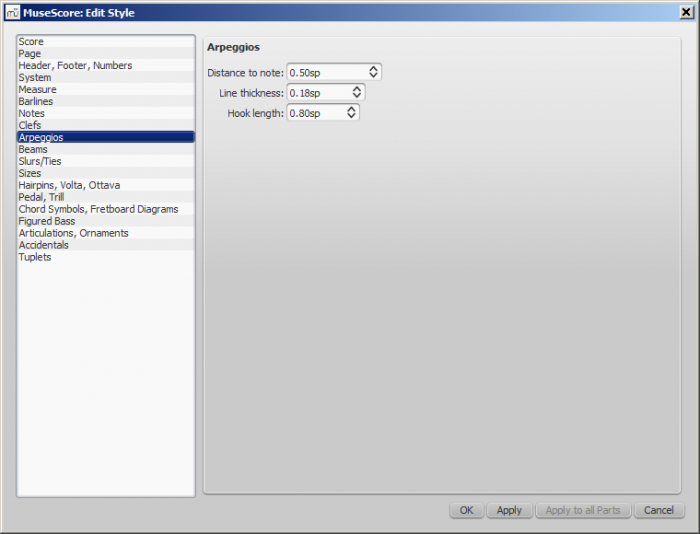
Here you can change the thickness, spacing and hook height of the following arpeggio and strum symbols:

Changes to these properties would be unusual.
General: Beams
Open from the menu: Style→General...→Beams.
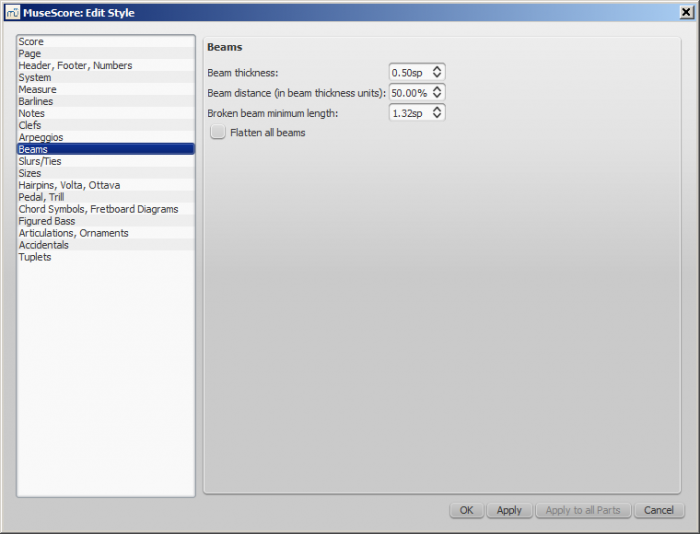
General: Slurs/Ties
Open from the menu: Style→General...→Slurs/Ties.

General: Sizes
Open from the menu: Style→General...→Sizes.
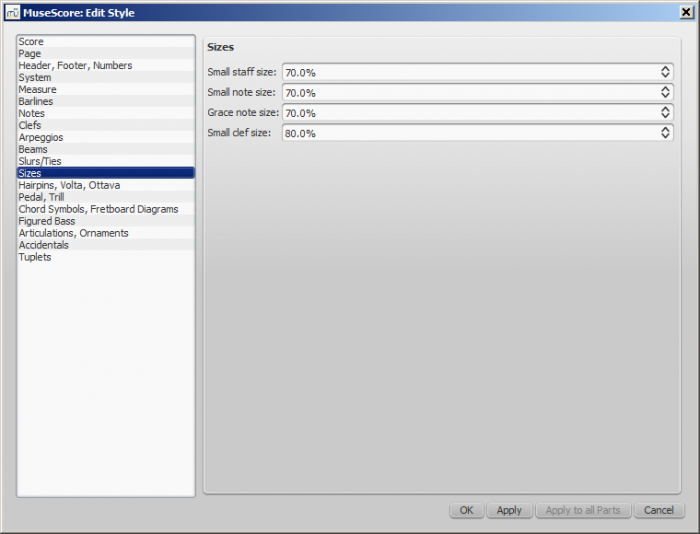
Sets the proportional size of "small" and grace notes, as well as small staves and clefs. Changing this would be unusual.
General: Hairpins, Volta, Ottava
Open from the menu: Style→General...→Hairpins, Volta, Ottava.
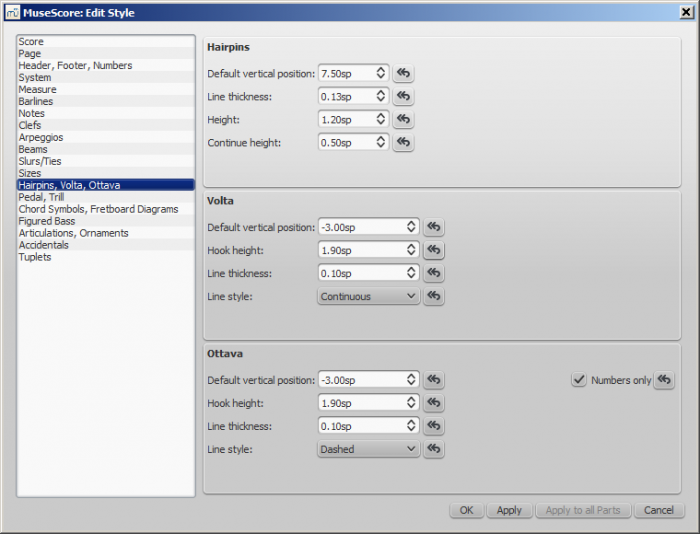
The  button returns the setting to the original value.
button returns the setting to the original value.
General: Pedal, Trill
Open from the menu: Style→General...→Pedal, Trill.
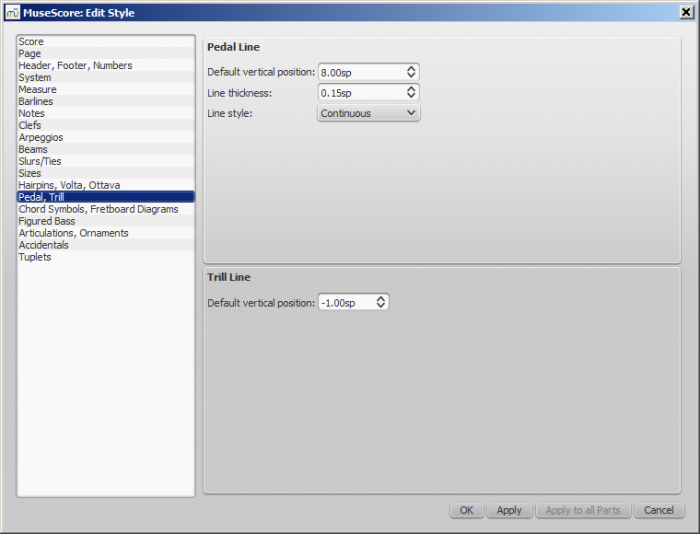
General: Chord Symbols, Fretboard Diagrams
Open from the menu: Style→General...→Chord Symbols, Fretboard Diagrams.
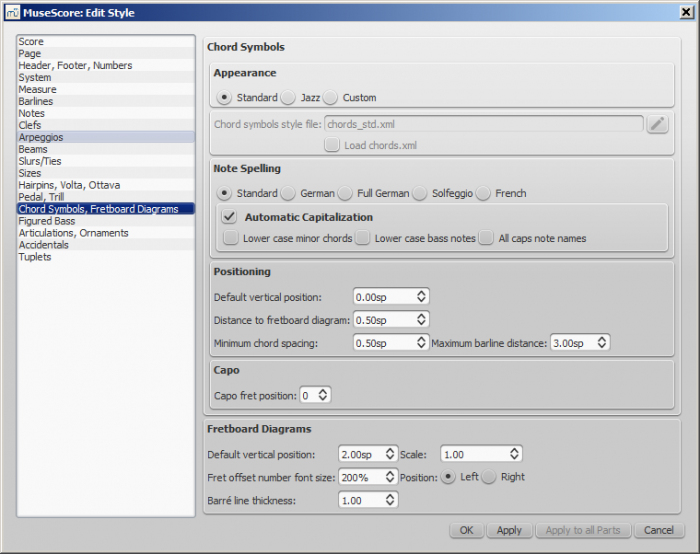
This section allows you to adjust the format and positioning of chord symbols and Fretboard diagrams.
Appearance: Chose a default chord symbol style—Standard, Jazz or Custom.
Note Spelling: Chose the spelling convention for chord symbols and whether to use capital or small letters.
Positioning:
- Default vertical position: The default vertical distance in space units (sp.) between a newly-applied chord symbol and the music staff. Negative values may be used.
- Distance to fretboard diagram: The distance (in sp. units) from a chord symbol to a fretboard diagram when both are applied to the same location on a staff. This value overrides the above "Default vertical position" setting. The user can chose to place a chord symbol below a fretboard diagram by entering a negative value.
- Minimum chord spacing: The minimum space to allow between chord symbols.
- Maximum barline distance: Increases the distance between the final chord symbol in a measure and the following barline. You may wish to adjust this value if there is a recurring problem in the score with overlap between the final chord symbol in one measure and the following chord symbol.
Capo: Enter the number of the capo position at which you want to display substitute chords, in brackets, for all chord symbols in the score.
Fretboard diagrams:
- Default vertical position: the distance in sp. units from a newly applied fretboard diagram to a staff. A negative value may be used.
- Scale: Increase or decrease the size of the fretboard diagram in the score.
- Fret offset number font size: Increase or decrease the size of a fret number displayed next to a diagram.
- Position Left/Right: Display fret number to the left or right of the fretboard diagram.
- Barre line thickness: Make barre lines in fretboard diagrams thicker or thinner.
General: Figured Bass
Open from the menu: Style→General...→Figured Bass.
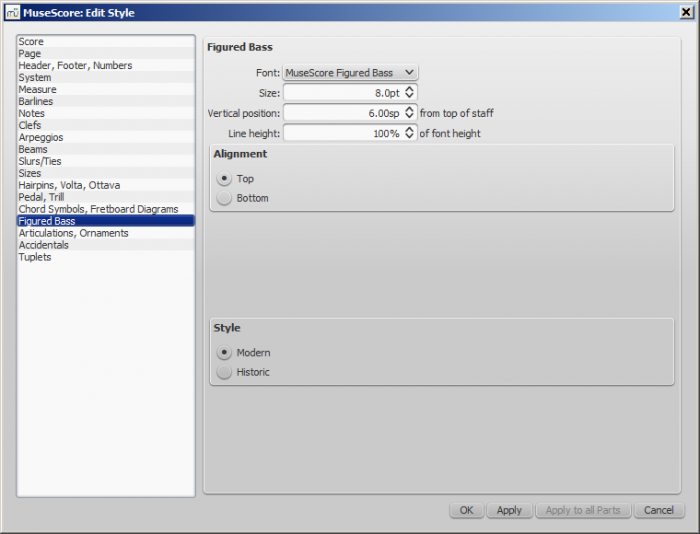
Options about figured bass font, style and alignment.
See also Figured bass
General: Articulations, Ornaments
Open from the menu: Style→General...→Articulations, Ornaments.
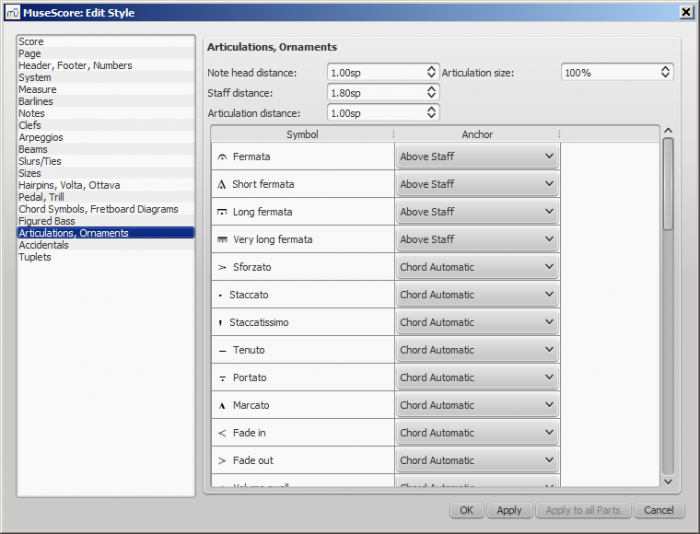
Position of articulation with respect to the notes and staves
General: Accidentals
Open from the menu: Style→General...→Accidentals.

Options about naturals at key signature changes
General: Tuplets
Open from the menu: Style→General...→Tuplets.
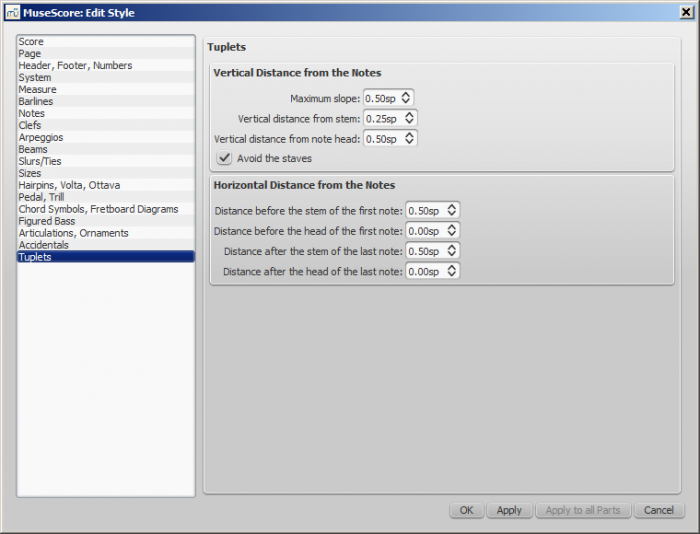
Apply and OK buttons
By pressing the Apply button you can see how the changes you have made in the dialogs affect the score without closing the window. Press OK to save your changes to the score and close the window.
Apply to all parts in one go
When in a part tab while changing layout and formatting, you can use the Apply to all Parts button to apply all changes (either in Layout→Page Settings.... or Style→General...) to apply the new settings to all parts in just one click.
Save/Load style
It is easy to transfer a complete set of styles (all General Style settings, all text styles, and page settings) from one score to the other using the Save/Load Style functions.
To save a customized style:
- Go to Style→Save Style....
- Name and save the style file (the default folder is set in your Preferences). Styles are stored as
*.mssfiles.
Note: You can also define a preferred style for scores and parts in the Score section of MuseScore's Preferences.
To load a customized style:
- Go to Style→Load Style....
- Navigate to and select the Style file (.mss) and click Open (or double click on the file).
All existing styles in the score should update automatically.
See also
External links
- Tutorial – How to create large-print stave notation (MSN)
- MuseScore in 10 Easy Steps: Part 10A Layout and Formatting (a video tutorial)
- MuseScore in 10 Easy Steps: Part 10B Layout and Formatting (a video tutorial)
General style: Measure
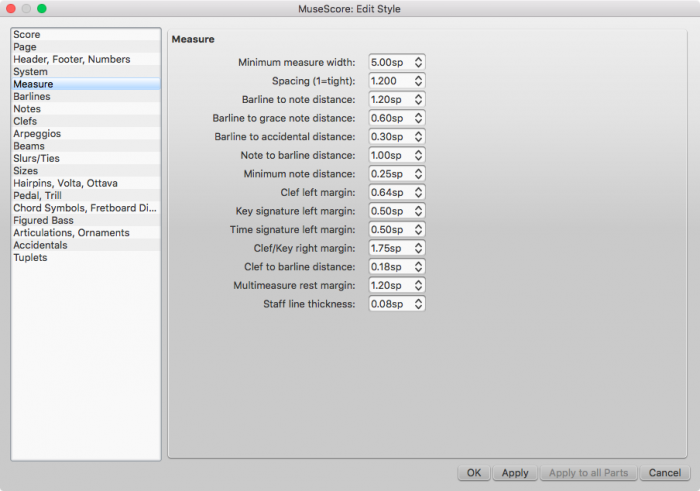
Style → General → Measure allows you to adjust the distance between various items within measures.
Introduction
If you change a measure style property (see image above), MuseScore automatically adjusts the score to maintain the correct spacing between notes and rests according to best music engraving practice. It will also correctly reposition any elements attached to notes or rests, such as fingerings, dynamics, lines etc.
All settings related to measure width and note spacing are minimum values. Measures are automatically stretched, if necessary, to maintain existing page margins.
All the properties listed below use the staff space (abbreviated to "sp") as the basic unit of measurement. See Page settings: Scaling for more details.
Options
-
Minimum measure width
Sets the minimum horizontal length of measures. In measures containing very little content (e.g., a single whole note or whole measure rest), the measure will only shrink as far as this minimum. -
Spacing (1=tight)
Condenses or expands the space after notes or rests. This setting thus affects not only space between notes but also between the last note and the ending barline. For the space between the beginning of the measure and the first note or rest, see Barline to note distance (below).Note: Changes to an individual measure's Stretch (under Layout → Increase Stretch, Decrease Stretch) are calculated after, and proportional to, the global Spacing setting.
-
Barline to note distance
Sets the distance between the barline which begins a measure and the first note or rest in that measure. For the initial measures of systems, which start with clefs instead of barlines, use Clef/key right margin (below). -
Barline to grace note distance
Sets the distance between a barline and a grace note that occurs before the first actual note in a measure (independently of the "Barline to note distance" setting). -
Barline to accidental distance
Sets the distance between a barline and an accidental placed before the first note in a measure (independently of the "Barline to note distance" setting). -
Note to barline distance
(To be added). -
Minimum note distance
Specifies the smallest amount of space MuseScore will allow after each note (depending on other factors, more space may be allowed). -
Clef left margin
Sets the distance between the very beginning of each line and the clef. (This option is rarely needed.) -
Key signature left margin
Sets the distance between the key signature and the clef preceding it. -
Time signature left margin
Sets the distance between the time signature and the key signature or clef preceding it. -
Clef/key right margin
Sets the distance between the material at the beginning of each line (such as the clef and key signature) and the first note or rest of the first measure on the line. (Note that, although not named in the option, if a time signature is present, it is the element from which the spacing begins.) -
Clef to barline distance
Sets the distance between a barline and a clef change preceding it. -
Multi-measure rest margin
Sets the distance between a multi-measure rest and the barlines on either side. -
Staff line thickness
Sets the thickness of the lines of the staff, which allows you to make the staff thicker and darker, if you need greater visibility on your printouts.
Page settings
Page settings allows you to adjust the overall dimensions of your score such as page size, page margins, and scaling. It is one of the main layout tools in MuseScore—along with the options available from Style→General...
To open the Page settings dialog: from the menu, select Layout → Page Settings....
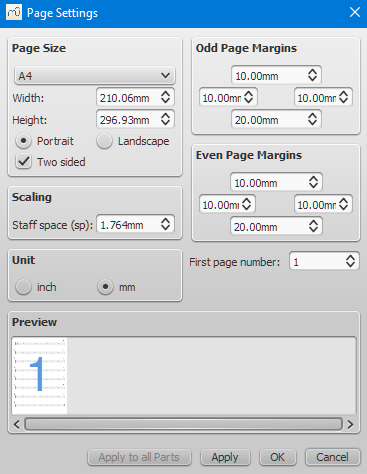
Page size
Here you can select the paper format, either by standard name (e.g., Letter or A4), or by specifying the height and width in either mm or inches (use the radio buttons to choose which unit of measurement to use). The initial default page size depends on your localization—in the United States, Letter size paper is standard.
You can also choose to format your music in Landscape or Portrait orientation using the radio buttons. Prior to version 2.1 unchecking Landscape enabled Portrait format. You can optionally use Two sided layout (i.e., book format, with mirror left and right margins for even and odd pages—see below).
Odd/Even Page Margins
The Even Page Margins and Odd Page Margins settings allow you to define the printable area of your pages. Aside from changing the margins around the music on the page, other settings, such as the positions of headers and footers, are calculated relative to the margins defined here.
If the "Two sided" checkbox under "Page Size" is selected, you can set margins differently for mirroring odd and even pages. Otherwise, only one set of margins can be modified, but will apply to all pages.
To display page margins in your score on screen (though not in print), go to View→Show Page Margins.
Scaling
The Scaling property allows you to increase or decrease the size of your score.
In MuseScore, the sizes of score elements, such as note heads, note stems, accidentals, clefs etc., are defined in terms of a unit of measurement called a staff space (abbreviated to "sp"). One staff space is equal to the space between two lines of a music staff (or one-quarter the size of the full five-line staff).
As you change the "Staff space" setting (under Scaling), all score elements follow suit and thus correct proportions are maintained. The exception is Text in which you can set an absolute value, independent of "Scaling."
Note: Changing the "Scaling" does not always change the number of systems per page, because system distance can vary between limits set under "Min system distance" and "Max system distance" (see Style→General...→Page).
Miscellaneous
First page number
Sets the number of the first page of the particular score. Page numbers below 1 won't get printed—e.g., setting the first page number to -1 would result in the first and second page showing no page number, and page number 1 appearing on the third page.
Apply to all Parts
The Apply to all Parts button is available when modifying a part, rather than the main score (see Part extraction). If you change the page settings of one part and want the rest of the parts to have the same settings, this button will apply the change to all parts in one go.
Breaks and spacers
The Breaks & Spacers palette in the Advanced workspace contains the following non-printing symbols:

The first three symbols are called breaks; the blue up and down arrows are known as spacers.
Breaks
A break can be applied to either a measure or a frame. There are three types:
- System break (called a line break prior to version 2.2): Forces the next part of the score to start in a new system.
- Page break: Forces the next part of the score to start on a new page.
- Section break: Divides the score into sections (see below), and forces the next part of the score to start in a new system. It can be combined with a page break if required.
Notes: (1) Blue break symbols are visible on the screen, but do not appear on printouts. (2) To add (or remove) system breaks over all or part of the score, see Add/Remove system breaks. (3) To split a measure, see Measure operations: Split and join.
Add a break to a measure
Breaks can be added using either (1) a keyboard shortcut; or (2) a break symbol from a palette.
Using a keyboard shortcut
To add a System (Line) break or a Page break only:
- Click on any one of the following elements:
- Barline;
- Measure;
- Measure range (as of version 2.2);
- Notehead (as of version 2.2);
- A text element associated with a staff (e.g. lyric syllable, chord symbol, staff text etc.) (as of version 2.2);
- Chose one of the following options:
- System (Line) break: Press↵ (toggle).
- Page break: Press Ctrl+↵ (Mac: Cmd+↵) (toggle).
Note: If you select a measure range, the break will be applied before and after the selection.
Using a palette symbol
Any break can be added from a workspace palette:
- Select any one of the following elements:
- Barline;
- Measure;
- Measure range (as of version 2.2);
- Notehead (as of version 2.2);
- A text element associated with a staff (e.g. lyric syllable, chord symbol, staff text etc.) (as of version 2.2);
- Double click a break symbol in a palette (toggle).
Note: If you select a measure range, the break will be applied before and after the selection.
- Alternatively, drag a break symbol from a palette onto a measure.
Add a break to a frame
To add a break to a frame, use one of the following options:
- Drag a break from a palette onto a frame.
- Select a frame then double-click a palette break symbol.
Move a break
To reposition a break:
- Enter edit mode for the break in question;
- Use the keyboard arrow buttons as described in Adjust position of text objects.
Delete breaks
Use one of the following options:
- Select one or more breaks and press Del.
See also: Add / Remove system breaks.
Section break
A Section break, as the name suggests, is used to create separate sections within a score. Like a system break, it forces the next measure or frame to begin a new system, and can also be used in association with a page break if required. A section break could be used, for example, to divide a piece into separate movements.
Each section can have its own measure numbering independent of the rest of the score. By default, the first measure of a section is numbered "1" (see image below), though like the first measure of the score itelf, the number is not displayed unless configured in the measure properties dialog. The same dialog can be used to change the numbering according to your preference.
If you change Time signature or Key signature at the beginning of the new section, there will be no courtesy signature at the end of the previous section. See example below:
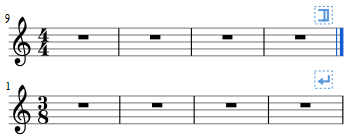
When you play back the score, the program adds a short pause between each section. In addition, the first end repeat barline in a section always sends the playback cursor to the beginning of the section, so a start repeat barline is optional.
Right click a Section break and select Section Break Properties... to specify:
- Pause length;
- If the new section's first system shows long instrument names;
- If the new section starts numbering measures at 1.
Spacers
A Spacer looks like a blue UP or DOWN arrow and is used to add extra space above or below a system (it cannot be applied to a frame).
Add a spacer
Use either of the following options:
- Select a measure, then double-click a palette spacer symbol.
- Drag a spacer symbol from a palette onto a measure.
Blue spacer symbols are visible on the screen, but do not appear on printouts.
Note: Spacers are designed for local adjustments only. If you wish to adjust the space between staves across the whole score, use the settings in Style → General... → Page instead.
Adjust a spacer
To adjust the height of a spacer, chose one of these options:
- Double-click the spacer and drag the blue end-handle up and down.
- Double-click the spacer and use the ↑ ↓ keys and/or Ctrl+↑ ↓ to move the end-handle up and down.
- Click (or double-click) on the spacer and adjust the height property in the Inspector.
Delete a spacer
- Click on the spacer and press the Del key.
See also
Frames
A Frame is a rectangular container for empty space, text or pictures in the score. It can be one of three types:
- Horizontal: Used to create a break in a particular system. Can contain one or more text objects and/or images.
- Vertical: Inserted above a system or appended to the last system. Can contain one or more text objects and/or images.
- Text: Inserted above a system or appended to the last system. Can contain one text object only.
Horizontal frame
A horizontal frame is used to create a break in a system. For example, you can:
- Create a coda, with an adjustable gap separating it from the rest of the score (as in the example below).
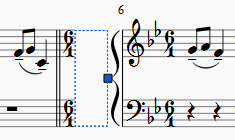
- Create an offset at the beginning of the score, where there is no staff name to perform the same function.
- Create an adjustable right margin at the end of a system.
- Create space for some text or image(s).
- Create a space between a 'historical incipit' and the beginning of the modern edition.
Insert/append horizontal frame
See Create a Frame (below).
Adjust width of horizontal frame
Use one of the following methods:
- Double-click the frame and drag the handle to the right or left.
- Select the frame and adjust "Width" in the Inspector.
Notes: (1) "Left Gap" and "Right Gap" are currently unused (version 2.x); (2) It is possible to create a 'Negative-width' horizontal frame, by dragging the edit-handle back over the left border of the frame. However, this is not a standard feature and once editing is finished you cannot reselect the frame.
Add text or image to horizontal frame
To add text:
- Right-click on the frame and select Add → Text.
To add an image:
- Right-click on the frame and select Add → Image.
Vertical frame
A vertical frame can be inserted above a system or appended to the last system. It can contain one or more text objects and/or images. The height is adjustable and the width equals the system width.
It can be used, for example, to:
- Create an area at the head of a score for Title/Subtitle/Composer/Lyricist text etc. (see below).
- Add single- or multi-column lyric text (at the end of a score).
- Create a title page.
- Create subtitles and other annotations between systems.
Insert/append vertical frame
See Create a Frame (below).
Adjust height of vertical frame
Use one of the following methods:
- Double-click the frame and drag the handle up or down.
- Select the frame and adjust "Height" in the Inspector.
Edit vertical frame properties
Selecting the frame allows you to adjust various parameters in the Inspector:
Top Gap: Adjusts distance between frame and element above (negative values not currently supported).
Bottom Gap: Adjusts distance between frame and element below (Negative values can be entered).
Height: Adjusts height of the frame.
Left Margin: Moves left-aligned text objects to the right.
Right Margin: Moves right-aligned text objects to the left.
Top margin: Moves top-aligned text objects downwards (see also Style → General... → Page).
Bottom Margin: Moves bottom-aligned text objects upwards (see also Style → General... → Page).
Add text or image to vertical frame
To add text:
- Right-click on the frame and select Add → Text/Title/Subtitle/Composer/Lyricist.
To add an image:
- Right-click on the frame and select Add → Image.
You can create as many objects as you like within a frame. Their positions can be adjusted independently by dragging or, more accurately, by altering the offset values in the Inspector. To format text objects, see Text editing and Text styles and properties.
Insert horizontal frame in vertical frame
- Right-click on the frame and select Add → Insert Horizontal Frame.
The horizontal frame is automatically left-aligned and fills the entire vertical frame. To right-align it:
- Reduce the width of the horizontal frame.
- Deselect the frame then drag it to the right. To restore left-alignment, drag the frame to the left.
"Title" frame
A vertical frame is automatically created at the beginning of a score, showing the title, subtitle, composer, lyricist etc., when you fill in the information fields provided on page 1 of the New Score Wizard.
If the score does not have a vertical frame at the beginning, you can create one as follows:
- Right-click on an empty space in the document window and select Text → Title/Subtitle/Composer/Lyricist.
Text frame
A Text frame looks like a vertical frame, but is specialised for text input: one text object is allowed per frame. The height automatically expands to fit the content and there is no height adjustment handle.
A text frame can be used, for example, to:
- Create lyric text at the end of a score.
- Create subtitles and other annotations between systems.
Insert/ append text frame
See Create a Frame (below).
Edit text frame properties
Selecting the frame allows you to adjust various parameters in the Inspector:
Top Gap: Adjusts distance between frame and element above (negative values not currently supported).
Bottom Gap: Adjusts distance between frame and element below (negative values can be entered).
Height: Not applicable to text frames.
Left Margin: Moves left-aligned text objects to the right.
Right Margin: Moves right-aligned text objects to the left.
Top margin: Moves top-aligned text objects downwards.
Bottom Margin: Moves bottom-aligned text upwards.
Create a frame
Insert a frame into the score
- Select a measure.
- Chose one of the following options:
- From the menu select Add → Frames → Insert...
- Right-click on an empty space in the score window and select Frames → Insert...
Append a frame to the score
Chose one of the following options:
- From the menu select Add → Frames → Append...
- Right-click on an empty space in the score window and select Frames → Append...
Delete a frame
Select the frame and press Del.
Apply a break
Line, page or section breaks can be applied to frames as well as measures. Use one of two methods:
- Select a frame and double-click a palette break symbol (for example, in the Breaks & Spacers palette).
- Drag a break symbol from a palette onto a frame.
See also
- Text Properties: to put a visual frame (border) around text.
- Insert measures: to insert measures before a frame.
External links
Images
You can use Images to illustrate scores, or to add symbols that are not included in the standard palettes. MuseScore supports the following formats:
- PNG (*.png)
- JPEG (*.jpg and *.jpeg)
- SVG (*.svg) (MuseScore currently does not support SVG shading, blurring, clipping or masking.)
Add image
Use one of the following options:
- Drag-and-drop an image file (from outside MuseScore) either into a frame or onto a note or rest in the score.
- Right-click on a frame, select Add→Picture, then pick an image from the file selector.
Cut/copy and paste image
- Click on an image in the score.
- Apply any of the standard copy/cut commands.
- Click on a note, rest or frame.
- Apply any of the standard paste commands.
Modify image
To modify the width/height of an image, double-click it and drag any of the handles. If you want to adjust width or height separately, untick "Lock aspect ratio" first in the Inspector.
You can adjust the position of an image by simply dragging it.
See also
External links
Image capture
MuseScore's image capture feature allows you to save a snapshot of any part of the score window. PNG, PDF and SVG formats are supported.
Save a snapshot
- Click on the Toggle image capture button,
 .
. - Press Shift + drag, to create a new selection rectangle.
- Fine tune the rectangle position, if required, by dragging it and/or changing the "Position" values in the "Lasso" section of the Inspector.
- Fine tune the rectangle area, if required, by dragging the handles, and/or changing the "Size" values in the Inspector.
-
Right-click on the selection rectangle to open the Image Capture menu. Select the desired option:
- Save As (Print Mode). This saves an image of the selection area as it would look if printed, e.g.
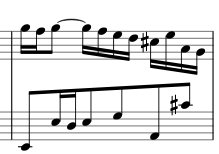
- Save as (Screenshot Mode). This saves a selection of the actual screen, including any line break symbols, invisible elements etc., e.g.
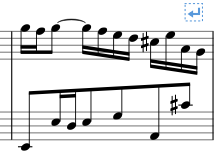
You can save the image in either PNG (default), SVG or PDF format.
- Save As (Print Mode). This saves an image of the selection area as it would look if printed, e.g.
Image capture menu
Right-clicking on the selection rectangle opens the Image Capture menu:
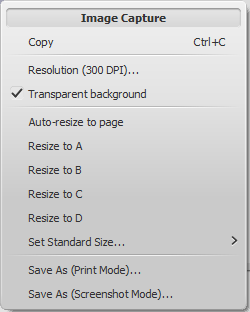
- Copy image: Chose this to copy an image before pasting it in the same or another MuseScore file.
- Resolution: Set the resolution, and hence the size of the saved or copied image. Try 100 dpi to start with, if you are unsure.
- Transparent background: Turn image transparency on or off.
- Auto re-size to page: Adjusts the selection rectangle to fit the page.
- Resize to A/B/C/D: Chose a customised selection rectangle (as set below).
- Set Standard Size: Resize the selection rectangle, then chose "Set size A/B/C/D" to store it.
See also
External links
Align elements
While dragging an element:
- Press Ctrl to constrain movement to the horizontal only.
- Press Shift to constrain movement to the vertical only.
Snap to grid
Snap to grid is a feature which allows you to drag an element in precise steps—useful for exact positioning.

To enable snap to grid, select an element and click one or both of the snap to grid buttons, located to the right of the horizontal and vertical offset fields in the Inspector. You can then drag the element in steps equal to the grid spacing. The default value is 0.5 sp.
To change the grid spacing:
- Right-click on any of the snap to grid buttons in the Inspector, and select Configure Grid.
- Set values for the horizontal and vertical grid spacing as required. Note that this is a fractional setting.